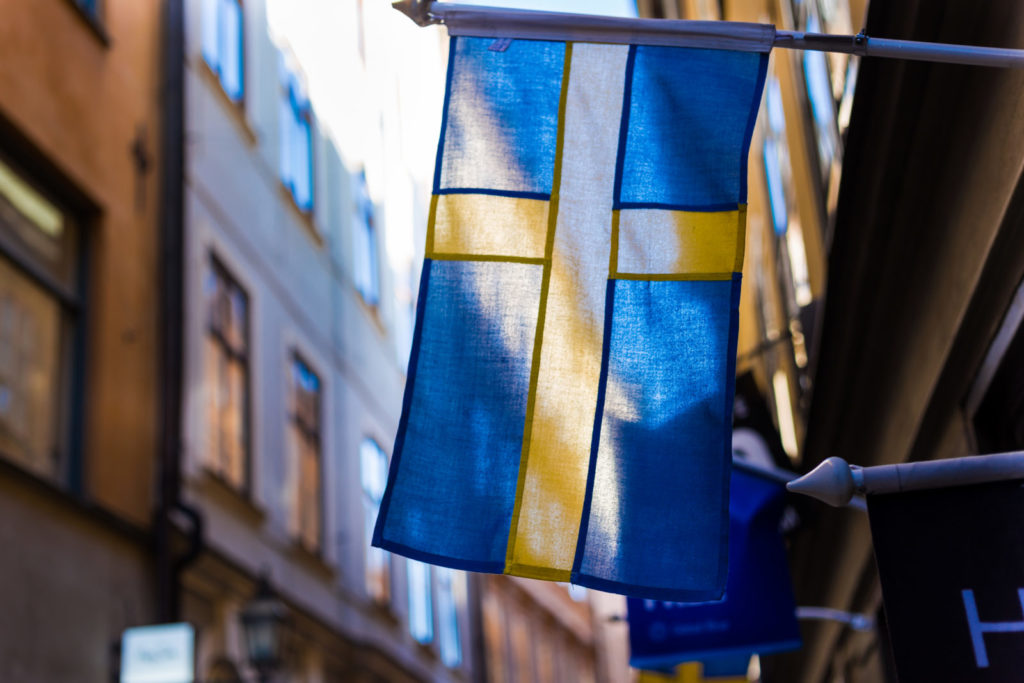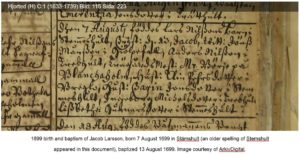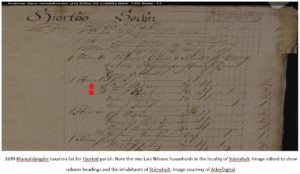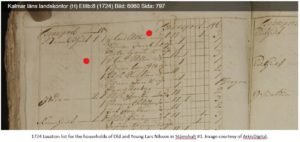The Tale of Two Lars Nilssons
 18
18Jan
Swedish genealogy can be both the best of times and the worst of times. A genealogist with Swedish heritage has much to be thankful for. The well-run centralized bureaucracies encouraged relatively consistent record-keeping practices. It is often possible to trace Swedish ancestry into the 1600s. The increasing population and the common repetition of the same given names and patronymic surnames required efficient bureaucratic institutions to keep track of the people, especially as the kingdom became a northern superpower during the period known as Stormaktstiden (Era of Great Power) in the 17th century. Taxing the people more efficiently was needed to support the ever-expanding manpower and logistical requirements of fighting wars, not just in the Baltic region, but throughout Europe. Your ancestors were undoubtedly caught up in all this, either as fighting men or as those supporting them.
With so few names available for given name and surnames, the true challenge of Swedish research is keeping them straight, and knowing which Lars Nilsson was your Lars Nilsson. You will need to utilize a relatively large group of records to distinguish your ancestors, especially as you move back in time. To be effective with Swedish genealogy, it is important to examine all available sources, particularly when household examination records either do not exist or when they lack the details needed to distinguish people of the same names within a parish, a village, or farm.
Good genealogical practice requires “reasonably exhaustive searches” and will be on guard against hasty assumptions. Nevertheless, there is room for creative thinking in the hunt for clues. Formulate and test new hypotheses when the standard sources lead to dead-ends. What follows is a case study concerning two Lars Nilssons who lived in 17th century Kalmar county.
One of my ancestors, Nils Svensson, had two sons named Lars Nilsson, both born in a small locality known as Stämshult, in the parish of Hjorted, Kalmar county, Sweden, in the years 1664 and 1669, respectively. It is usually assumed that when a given name is re-used for another child, that the former bearer of it had likely died young. This assumption is understandable, as it was a common occurrence. Furthermore, deaths and burials of young children, particularly infants, went unrecorded in parish registers in earlier time periods. Because of this, previous researchers apparently thought that the Lars Nilsson who was born in 1664 must have died during his early childhood, since five years later another male sibling was also named Lars.
Hasty assumptions are the bane of good research. It turns out there were two Lars Nilssons residing in Stämshult, and both married and had children at about the same time. Earlier researchers assembled them as one family, beginning with the first child in 1695, but, unfortunately, ignored discrepancies. One must keep searching and not fall victim to “same name syndrome.” As one who has traced many Swedish ancestors for clients, I have seen several cases of two siblings with the same name, particularly sons, who both reached adulthood, married, had children, and lived to a ripe old age.
On the family group record, when a death date is not found for a child, we should not indicate that they died young if another child is given the same name. This will likely cause later researchers to close off their mind to the possibility that there could be two living children of the same name with the same parents.
Pay attention to clues and to discrepancies. The baptismal records of the children of these two Lars Nilssons contained clues, such as Lars Nilsson the elder and Lars Nilsson the younger. In the 1600s, mother’s names were often not listed on the birth and christening records of their children. However, for this place, some of the entries named the mother of the child. This was critical to sorting the children, because the marriages of both Lars Nilssons also occurred in their native parish of Hjorted.
Church records by themselves are often not sufficient to know which child went with which family. Sometimes, no clues are provided. This was particularly the case with Jacob Larsson, son of one of the Lars Nilssons of Stämshult. Since Jacob is my direct ancestor, it was essential to discover the truth. Knowing Jacob’s mother’s pedigree was also at stake.

There are other dangerous assumptions to watch for. If a record shows no additional identifiers for an individual beyond where he lived and his name, it would be easy to think that he must have been the only person living in that area with that name. The “reasonably exhaustive search” standard requires that further sources be consulted. The 1699 mantalslängder taxation list for the parish of Hjorted, which includes the taxable heads of household, shows that there were two Lars Nilssons. Which one was Jacob’s father?

The year 1699 is the same year that Jacob was born.[1] There were two married men named Lars Nilsson, residing not only in Stämshult, but even at the same farm number. Notice the abbreviations “gl:” and “U:”, which appear in front of the two Lars Nilssons. These abbreviations stand for the Swedish words “gammal” and “unge,” which translate into English as “old” and “young.” These designations are an important discovery, and one can justly hypothesize that the two apparent brothers remained in Stämshult. Since the two Lars Nilssons succeeded the above-mentioned Nils Svensson on the tax lists for this parish, and Nils had two sons named Lars, this is supporting evidence that the older Lars and the younger Lars are both Nils Svensson’s sons. Remember, no death record of the oldest Lars Nilsson (born 1664) was found in the Hjorted parish register.
Some people think that parish clerks in Sweden never missed recording a birth or death in their congregation, but it did happen, particularly before the nineteenth century. This assumption sometimes has led researchers to prematurely give up on that line. Again, a “reasonably exhaustive search” can often move the pedigree back past the apparent brick wall.

These mantalslängder tax lists act as an annual census, and for thirty-eight years, from 1691 to 1729, the Lars Nilsson brothers were continuously listed as heads of household at Stämshult #1, Hjorted parish. It is helpful to use an Excel spreadsheet or a well-organized research log to keep track of information for each tax year. This 1724 tax list is the first one that mentions Jacob Larsson, age 20, in the household of the older Lars Nilsson.
When one problem is apparently solved, genealogists commonly find that another question arises. In this case, if Jacob was age 20 in 1724, he would have been born in 1704. But, the only likely Jacob, son of Lars Nilsson, was born in 1699. One might think the 1699 Jacob died young and another child was given the same name. Lars Nilsson had a son named Sven Nilsson in 1704, and Sven’s burial record mentioned that he was the son of the older Lars Nilsson. It is common for ages in the tax lists to be a little off, so Jacob was likely a little older than 20 in 1724. After determining the respective marriages for the two Lars Nilssons, the first to Brita Hansdotter in 1692 and the second to Ingred Bengtsdotter in 1697, it was possible to sort the children with their respective parents.
The genealogists at Price Genealogy have in-depth experience with a wide range of records unique to Sweden which can help extend your ancestry beyond apparent dead ends. Daily research experience in Swedish records helps us avoid the assumptions trap. Utilizing a “reasonably exhaustive search” strategy will often overcome otherwise unsolvable barriers. The sources mentioned in this article do not exhaust all the records at our disposal to solve your pedigree challenges. We love Swedish research and we can help you learn more of your Swedish ancestors.
[1] Hjorted C:1 (1633-1739), ArkivDigital, Image 115 / page 223 (AID: v38992.b115.s223, NAD: SE/VALA/00134) [Source: Arkiv Digital AD AB], baptism entry of Jacob Larsson, born 7 August 1699, accessed 17 January 2018. All references to events and persons are found through ArkivDigital. Citations are provided upon request.
